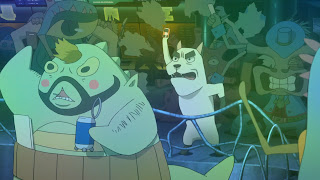In glorious Blu-ray comes Welcome to the Space Show, the latest import from the Japanese big screen to grace my screen. I actually saw a trailer for this when I was in Japan last May, at a screening of Bungaku Shoujo and it caught my eye immediately. And boy, does the real deal look great – gorgeously animated with eye-catching character designs. It has some terrific music, too, mostly in English. But what of the movie itself – is it worth your time?
This is one of A-1 Pictures first ventures into film, though they’ve certainly had a great run on TV in the last couple of years. Given the production values they generally deliver it’s not surprising what they can do with a real budget. In the director’s chair is Koji Masunari, best-known as the director of the Read or Die works, and for being the creator and pretty much one-man gang behind Kamichu. And it’s that series that should give you a decent template for what to expect here thematically, for better and for – well, not worse, but less better.
I’m not going to try and really explain the plot, because it’s incredibly convoluted in the details. This is a long movie, clocking in at a legit 145 minutes – and there’s not a lot of dead time in there. It drags at times, frankly, and suffers from plot overload. Make no mistake, this is a children’s film – it’s not edgy or dark or experimental. It’s fun and heartwarming and the emotional palette is as straightforward as the visual one is bright. But 145 minutes is a lot of time to sustain story and character development that isn’t even trying for complexity.
In brief, the story concerns five kids – two boys, Kiyoshi and Koji and three girls, Natsuki, Noriko and Amane – from a small mountain town who go away for a sort of unsupervised week-long sleepaway camp during their summer break. Why unsupervised? Because all the grown-ups trust Kiyoshi, the oldest of the kids at about 13 (the youngest, Amane, might be 6 or so). They’re all voiced by real kids and that lends an air of authenticity to their scenes together. They’re archetypes, for sure – the responsible one everyone admires, the geek, the screw-up… And there’s tension between siblings, too. It’s all pretty standard, but that’s not surprising when you’re trying to connect with a young audience. During their adventures they meet a talking dog named Pochi, who turns out to be an alien from the planet BOW, a sort of botanist doing some research who was injured protecting the planet from poachers. They take care of his injuries and in gratitude he offers them a “class trip” – to the moon – and the adventures begin.
What works? There are terrific visuals, as I said – I love the conceit that the moon we see from Earth is just a facade, a kind of billboard with a thriving intergalactic spaceport hidden behind it. There’s a plethora of bizarre and comedic aliens that will surely appeal to sci-fi geeks of all ages. The hook – wasabi is actually a powerful controlled substance in great demand throughout the universe – is cute. And the warmth between the five characters and Pochi is genuine. All of the child actors are at least pretty good, and Pochi is voiced by the wonderful Keiji Fujiwara. There’s an avalanche of interesting visuals that just never seems to stop, as the story flows from one magical place to another.
What doesn’t work so well? The dreaded third act, for starters – it really does drag, a victim of the aforementioned length and plot fatigue. The villains are pretty generic and don’t leave much of an impression. If you’re not a child, all of the cliches at the heart of the movie will be apparent and occasionally distractingly painful. It really is the magic of Miyazaki that he can make a movie for children that will never bore adults, but there aren’t many others who can do it.
On balance, though, if you’re able to check your cynicism at the door and watch “Space Show” with a sense of fun and a willingness to be moved by straightforward emotional drama, you’ll enjoy it a lot. It’s a great-looking movie that’s all heart – a space adventure the way a kid would dream it up. And surely, that’s exactly what it’s trying to be.






